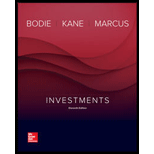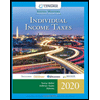
Investments
11th Edition
ISBN: 9781259277177
Author: Zvi Bodie Professor, Alex Kane, Alan J. Marcus Professor
Publisher: McGraw-Hill Education
expand_more
expand_more
format_list_bulleted
Question
Chapter 28, Problem 8CP
A
Summary Introduction
To explain: The risk objective of investment policy.
Introduction: The objective of risk management policy is to provide funds with a higher amount according to the interest rate but after a long period of time. Here, in this case, the time period is 18 years and the rate is 40%.
B
Summary Introduction
To explain: Pretax rate for the investment policy.
Introduction: While evaluating the risk a large amount of investment is required and put that amount into risk for a long period but after time it gives a long return.
C
Summary Introduction
To explain: All the constraints of investment policy.
Introduction: Constrains are time horizon, liquidity requirements, tax concern and unique circumstances. Out of these constrains tax concern and unique circumstances are profitable.
Expert Solution & Answer
Want to see the full answer?
Check out a sample textbook solution
Students have asked these similar questions
Which of the following is considered a long-term financing source for a company?A) Accounts PayableB) Common StockC) Short-term loansD) Accrued Expenses
Which of the following best defines the term "capital structure"?A) The way a company raises its capital through debt and equityB) The investment decisions made by a companyC) The amount of profit a company generatesD) The distribution of earnings to shareholdersneed help
Which of the following is considered a long-term financing source for a company?A) Accounts PayableB) Common StockC) Short-term loansD) Accrued Expenses
Knowledge Booster
Similar questions
- Which of the following best defines the term "capital structure"?A) The way a company raises its capital through debt and equityB) The investment decisions made by a companyC) The amount of profit a company generatesD) The distribution of earnings to shareholdershelparrow_forwardWhich of the following best defines the term "capital structure"?A) The way a company raises its capital through debt and equityB) The investment decisions made by a companyC) The amount of profit a company generatesD) The distribution of earnings to shareholdersarrow_forwardThe time value of money concept is based on the idea that: A) Money loses value over timeB) Money has the same value over timeC) The value of money increases over time due to inflationD) A dollar today is worth more than a dollar in the futurehelparrow_forward
- The time value of money concept is based on the idea that: A) Money loses value over timeB) Money has the same value over timeC) The value of money increases over time due to inflationD) A dollar today is worth more than a dollar in the future explain.arrow_forwardThe time value of money concept is based on the idea that: A) Money loses value over timeB) Money has the same value over timeC) The value of money increases over time due to inflationD) A dollar today is worth more than a dollar in the futurearrow_forwardWhich of the following is the most appropriate metric for determining a company's profitability?A) Return on Assets (ROA)B) Debt-to-Equity RatioC) Price-to-Earnings (P/E) RatioD) Current Ratio need helparrow_forward
- Which of the following is the most appropriate metric for determining a company's profitability?A) Return on Assets (ROA)B) Debt-to-Equity RatioC) Price-to-Earnings (P/E) RatioD) Current Ratio explain.arrow_forwardWhich of the following is the most appropriate metric for determining a company's profitability?A) Return on Assets (ROA)B) Debt-to-Equity RatioC) Price-to-Earnings (P/E) RatioD) Current Ratioarrow_forwardWhat does the term "liquidity" refer to in financial management?A) The profitability of a companyB) The ease with which an asset can be converted into cashC) The long-term sustainability of a companyD) The company's capital structure helparrow_forward
- What does the term "liquidity" refer to in financial management?A) The profitability of a companyB) The ease with which an asset can be converted into cashC) The long-term sustainability of a companyD) The company's capital structurearrow_forwardWhich of the following is a method for valuing a stock using expected future dividends?A) Net Present Value (NPV)B) Dividend Discount Model (DDM)C) Price-to-Earnings (P/E) RatioD) Internal Rate of Return (IRR) explain.arrow_forwardWhich of the following is a method for valuing a stock using expected future dividends?A) Net Present Value (NPV)B) Dividend Discount Model (DDM)C) Price-to-Earnings (P/E) RatioD) Internal Rate of Return (IRR)arrow_forward
arrow_back_ios
SEE MORE QUESTIONS
arrow_forward_ios
Recommended textbooks for you
 Individual Income TaxesAccountingISBN:9780357109731Author:HoffmanPublisher:CENGAGE LEARNING - CONSIGNMENT
Individual Income TaxesAccountingISBN:9780357109731Author:HoffmanPublisher:CENGAGE LEARNING - CONSIGNMENT




Individual Income Taxes
Accounting
ISBN:9780357109731
Author:Hoffman
Publisher:CENGAGE LEARNING - CONSIGNMENT

